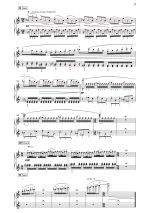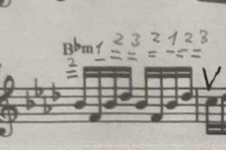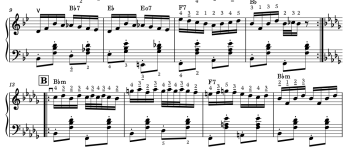I have just been noting things I discover with my favored fingering with using notation ROW/Finger. Finger only does not provide all the information. I play a C-gris keyboard so things magically appear easier using the 4th row vs the first row. I am a long time PA accordion player hence the question.
You are using an out of date browser. It may not display this or other websites correctly.
You should upgrade or use an alternative browser.
You should upgrade or use an alternative browser.
Notation standard for CBA fingering?
- Thread starter jfeagans
- Start date
Jelena Milojevic just responded to my question and said:
"First 3 rows are marked with numbers 1,2,3,4,5 for fingers thumb(1)-pinky(5). Top 2 rows different teachers mark differently, I circle the number, some put line under the number -, some put + next to a number, and some put *. Some teachers mark 4th row with one +, and 5th row with two++."
"First 3 rows are marked with numbers 1,2,3,4,5 for fingers thumb(1)-pinky(5). Top 2 rows different teachers mark differently, I circle the number, some put line under the number -, some put + next to a number, and some put *. Some teachers mark 4th row with one +, and 5th row with two++."
Jelena Milojevic just responded to my question and said:
"First 3 rows are marked with numbers 1,2,3,4,5 for fingers thumb(1)-pinky(5). Top 2 rows different teachers mark differently, I circle the number, some put line under the number -, some put + next to a number, and some put *. Some teachers mark 4th row with one +, and 5th row with two++."
Apparently there was an international conference of all the leading accordion teachers some years ago with only one goal: to agree on an international standard for fingering notation so that the accordion could enjoy the degree of consistency of other instruments for music publishers. You can guess what happened - the conference ended with no agreement and the universe of one remained the status quo!
To add yet another way of fingering notation, my cheap scoring programme doesn't do circles, lines, asterisks, pluses or amusing emojis for fingering, just the bare number. My solution was to change the colour of the notes when they are on a helper row. I personally find this clean and easy to read rather than a system that looks like ants have been fighting on the page. Doubtless it would have provoked bloodshed at the aforesaid conference!

btw - here is your lady Jelena Milojević with the great Cory Pesaturo!
I give you a lot of credit Ben! That seems too challenging for me, despite the colored notes!Apparently there was an international conference of all the leading accordion teachers some years ago with only one goal: to agree on an international standard for fingering notation so that the accordion could enjoy the degree of consistency of other instruments for music publishers. You can guess what happened - the conference ended with no agreement and the universe of one remained the status quo!
To add yet another way of fingering notation, my cheap scoring programme doesn't do circles, lines, asterisks, pluses or amusing emojis for fingering, just the bare number. My solution was to change the colour of the notes when they are on a helper row. I personally find this clean and easy to read rather than a system that looks like ants have been fighting on the page. Doubtless it would have provoked bloodshed at the aforesaid conference!

I believe that Jelena now lives on Victoria Island, British Columbia, Canada... teaches there at a university, if I recall.
I use a _ underline for 4th and 5th row. There is no confusion between these rows (because notes appear either on the 4rd or the 5th row, not both). So if someone uses + then using two ++ is really redundant. A single + is always enough, just like my single _ is enough.Jelena Milojevic just responded to my question and said:
"First 3 rows are marked with numbers 1,2,3,4,5 for fingers thumb(1)-pinky(5). Top 2 rows different teachers mark differently, I circle the number, some put line under the number -, some put + next to a number, and some put *. Some teachers mark 4th row with one +, and 5th row with two++."
craigd
Active member
I believe that Jelena now lives on Victoria Island, British Columbia, Canada... teaches there at a university, if I recall.
Hey Jerry, I made the same mistake before I moved out here to Vancouver Island, on which the capital city of British Columbia, Victoria, is located. And yes I think you're right that she teaches down there at the university.
Thanks for the correction!!Hey Jerry, I made the same mistake before I moved out here to Vancouver Island, on which the capital city of British Columbia, Victoria, is located. And yes I think you're right that she teaches down there at the university.
Seems like mission impossible to standardize fingering across different CBA schemes and PA. I worked with standards committees in my former career trying to get dial up modems to interoperate! The responses gave some good ideas for what I am doing to markup scores.
Joakim Monsen
Member
I use underlines in MuseScore Studio with the Academy Engraved LET font because the underline is more distinct and easier to see than with other fonts. When I have time (since it takes more effort in MuseScore), I’ll use circles instead — they’re even clearer to read. That said, underlines can sometimes be mistaken for tenuto markings, so it’s not a perfect solution.
In some Balkan traditions I’ve worked with, the approach is to use two underlines for the 5th row and three lines for the 6th row — a practical workaround that communicates the layout clearly.
In the end, the best system is the one that works for you. Just be sure to clearly annotate in the sheet music margins what each symbol means — it keeps everything readable and consistent, especially when you revisit the piece later.
In some Balkan traditions I’ve worked with, the approach is to use two underlines for the 5th row and three lines for the 6th row — a practical workaround that communicates the layout clearly.
In the end, the best system is the one that works for you. Just be sure to clearly annotate in the sheet music margins what each symbol means — it keeps everything readable and consistent, especially when you revisit the piece later.
Attached a few examples to show how this looks in practice — might be useful if you’re experimenting with your own system.
Attachments
Siegmund
Well-known member
I find that I don't pencil in many fingerings: rather I give myself notes when to reposition my hand. I have my own set of names for the most common hand positions, and sometimes put a block of 4 or 5 dots above the music (in a V or W or whatever other pattern) to indicate the intended positions of my fingers on the upcoming sequence of notes.
But I seem to be in a small minority, for doing that rather than just putting in numbers.
I agree that most common is to use plain numbers for the first 3 rows and some kind of symbol (I think I see circles more often than + or *) for the back two rows.
Sometimes I just need to write "back!" or "front!" in the music, when my hand instinctively wants to go the other direction, too.
But I seem to be in a small minority, for doing that rather than just putting in numbers.
I agree that most common is to use plain numbers for the first 3 rows and some kind of symbol (I think I see circles more often than + or *) for the back two rows.
Sometimes I just need to write "back!" or "front!" in the music, when my hand instinctively wants to go the other direction, too.
micahcowan
Active member
I find that I don't pencil in many fingerings: rather I give myself notes when to reposition my hand.
I've been thinking lately that I may start doing this for left-hand positions, particularly for bass-note solos, as it's helpful to understand at a glance what the center of the current scale is, which I think just might prove a more reliable indicator of when to use the counter-bass notes, than seeing them individually marked.
I don't think I'll take this approach for the right hand, though - on "virtuosic" passages, my hands are changing positions too frequently and too variously for the notion of a "position" to hold for long - noting the individual notes seems to work best for me.
Similar threads
- Replies
- 8
- Views
- 1,755
- Replies
- 15
- Views
- 1,422
- Replies
- 1
- Views
- 183



